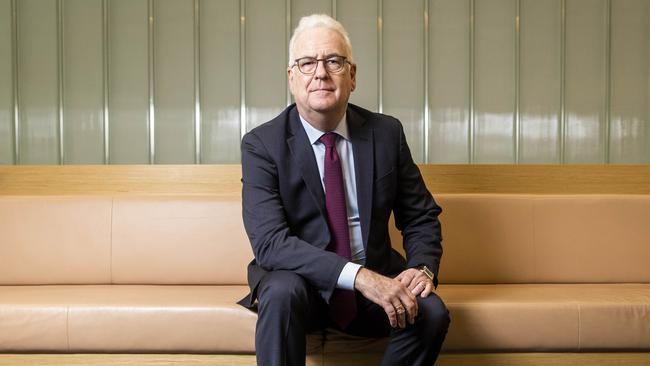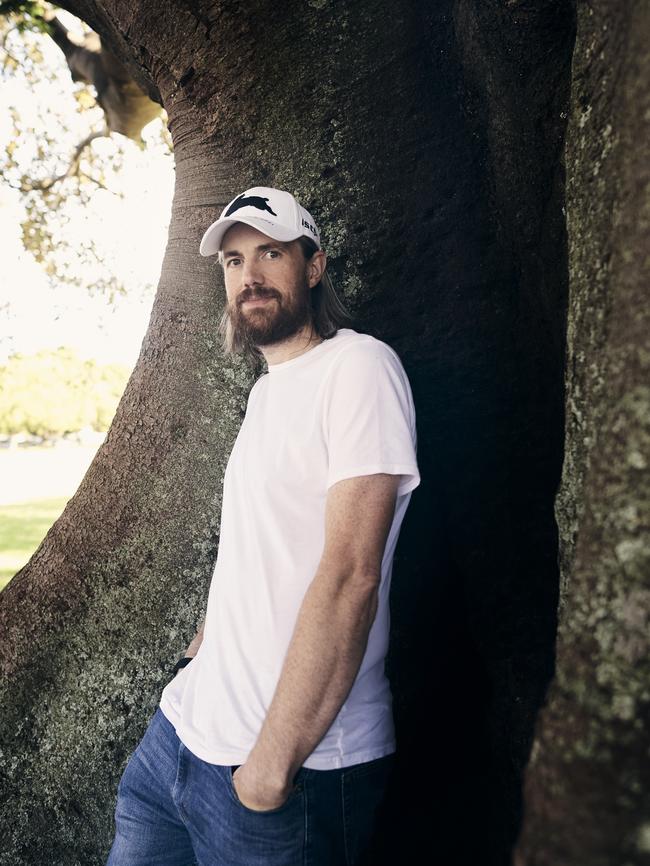How AGL plans to fight back against Mike Cannon-Brookes
AGL’s seasoned CEO says a rapid green switch will cost billions more and everyone will pay.

If there was a faster, more economical way for AGL to switch off its giant coal-fired power generators without disrupting the electricity grid or pushing up prices for customers, then Graeme Hunt would do it.
The seasoned chief executive says it is not that simple. Australia can’t just “wish” for AGL’s green transition to come about in 10 years. Tens of billions need to be spent replacing the equivalent amount of generation taken out of the market, infrastructure needs to be built and the ageing power grid has to be overhauled.
“Where are their projects? Because you just can’t just wish this to happen faster. You have to have advanced projects, you have to know where to build them, you need approvals,” Hunt says. “Building out this kind of change is not long enough or credible.”
Hunt, who is now faced with fending off a $5bn takeover offer, has come out swinging against his stalkers the tech billionaire Mike Cannon Brookes and Canada’s Brookfield. After parachuting into the top AGL job last year following the sudden exit of Brett Redman, this is his third stint as a public company CEO, including a role as BHP’s former iron ore boss. Most recently he was known for his role in turning around Transfield and securing a $1bn takeover for the industrial group.

He says plans by Cannon-Brookes and Brookfield to accelerate AGL’s exit from coal ignore the reality of the nation’s electricity grid.
He points out AGL has its own commercial timetable for a coal exit and he maintains there are “pools of capital” available to the company to help it get there. This includes pushing ahead with a planned split of AGL’s renewables and retail from its coal-fired generation operations into separate businesses.
“It’s about getting it done in a responsible and considered way and retiring thermal generation only when you’ve got the replacement capacity – not just generating but firming capacity – in place,” Hunt says.
“We’re sitting here, it’s almost March 2022, they suggest our coal will be gone in 10 years. Our Bayswater operations and Loy Yang are the lowest-cost producers in NSW and Victoria respectively. So pulling those out more quickly, in advance of others, is going to mean that whatever is left at the time is more costly generation.”
Nor can AGL operate in isolation, he says. The company’s coal-fired power plants generate nearly a third of both states’ electricity needs, keeping the lights on in the suburbs and powering large industrial customers including energy-sucking aluminium smelting plants. Just last week rival Origin gave the required notice that it was planning to shut down its massive Eraring coal-fired generator in NSW seven years early in 2025, which means there will be more pressure on the AGL generators.

The battle for AGL is turning into a multi-layered fight. It puts the relative youth of Cannon-Brookes and his millennial partner, the Brookfield Asia-Pacific dealmaker Stewart Upson, up against one of the nation’s oldest companies.
It puts 21st renewable technology in a fight against Victorian-age industrial muscle, but most of all, the bid inflames the bitter politics of the power market.
Prime Minister Scott Morrision, facing an election by May, has talked up intervention in the bid to secure the electricity supplies. It has been suggested Brookfield, a majority partner in the bid consortium, could be blocked under a critical infrastructure designation by the Foreign Investment Review Board.
It would be a big call to do this to a Canadian company that already owns port and rail infrastructure as well as Australian hospitals that are packed with sensitive medical records. However, Australia has been here before when two other Liberal treasurers and one Labour treasurer have stood in the way of free markets.
The then Treasurer Peter Costello blocked Shell’s planned takeover of Woodside in 2001, Wayne Swan rejected Singapore Stock Exchange’s move on the ASX in 2011 and two years later Joe Hockey stood in the way of US-based Archer Daniels Midland moving on bulk grains handler GrainCorp. In all cases the decisions were made on national interest grounds.
Hunt says any decision on this is a matter for the government, but points out it’s a moot point as there is no deal being pursued.
The Cannon-Brookes and Brookfield bid, delivered to AGL over the weekend, was quickly rejected for not offering enough of a premium to change control of the company. The bidders, who want to accelerate AGL’s exit from coal, haven’t ruled out going hostile or pushing AGL’s board into a further round of talks.
While the Cannon-Brookes and Brookfield consortium have promised 7-9 gigawatts of renewable power generation to replace AGL’s 6.8 gigawatt coal output, Hunt wants to see the plan.
“It’s not a 1GW for 1GW replacement between thermal and renewables,” he says.
“You need two and a half to three times as much renewables to replace that coal-fired generation because of the fact the sun doesn’t always shine and the wind doesn’t blow.”
He puts a back-of-the-envelope cost of $30bn just to replace the equivalent reliable power generation with renewables. And then it depends on what is happening with the rest of the power grid and whether it can keep up with the intermittent supply.
Hi-tech Coles
Hi-tech supermarkets
The 600-Series bot, the Orbit, Flex and the Smart Grids. No, it’s not another reboot of Blade Runner, it’s how Coles plans to deliver milk, bread and other groceries to your door.
The supermarket major is preparing for the next wave of growth in home deliveries, an area that has already been turbocharged through Covid and has reached for cutting-edge technology in getting this done.
Coles is already working with UK logistics operator Ocado in building two giant smart warehouses, one in Sydney and another in Melbourne, to get groceries delivered to its stores cheaper and faster than its current supply chain.
Coles will continue to manage its own website, but eventually plans to hand over the management, the back end and delivery to Ocado.
The “last mile” delivery has been a perennial problem in Australia, given vast distances and low density of suburbs resulting in higher costs. And scale and better technology are the only way to get these costs down.

The move to outsource delivery comes with substantial risk as it could see Coles lose control of the end customer experience in an area critical to its growth.
Delivery is the new battleground for the big supermarkets. Woolworths is building its own network of micro-fulfilment supermarkets that pick, pack and dispatch groceries to consumers within a day. Woolworths believes its move, which leverages its existing store network, puts it closer to customers.
During the December half, home delivery for Coles represented 8.2 per cent of all sales.
While it is still a relatively small number, online sales remain the fastest-growing part of Coles’ business, up more than 46 per cent from the same time a year earlier.
The figures came as Coles on Tuesday posted a 2 per cent fall in first-half net profit to $549m. Overall sales rose 1 per cent to $20.79bn.
Coles also likes digital sales as customers who both shop online and visit stores generally spend more per shop and are more likely to be members of the Flybuys loyalty scheme.
“Our best customers shop online and in-store,” Coles boss Steven Cain says.
Cain flew over to London in December to get a first-hand update on where Ocado is moving and he says it is “astonishing where Ocado is heading from an automation point of view”.

Just last month, Ocado showcased its cutting edge “ReImagined” home delivery platform, which brings together technology from a series of acquisitions it made in recent years.
Among these is the 600-Series smart bot which picks groceries from a grid inside the warehouse. Nearly half the components in the robot are 3D-printed, making it lighter and energy efficient.
Ocado also outlined a robotic arm powered by AI, which can pick products from shelves including fragile items and pack them into bags. For online, Ocado’s Flex product integrates its AI technology with the Coles website for a further personalised experience. It’s new home delivery platform offers an “optimisation algorithm” which Ocado says makes millions of calculations per second to identify optimal delivery journeys.
Ocado’s founder and chief executive Tim Steiner says his robot technology offers customers a new level of choice the ability to handle 50,000 different products this compares to an average Australian supermarket carries over 20,000 lines.
“Choice also means receiving the perfect order, exactly what you ordered. No substitutions every time,” Steiner told an investor briefing last month.
He noted that increasingly home delivery customers want to receive their orders when it suits them on the weekend or after work which is another layer of bespoke service.
Importantly, customers want the retailer that have good value “which means low operating costs and an ultra-efficient last mile”.
“The successful retailers have always been the ones that have been cost dominating in their field,” he said. “The winners in grocery will be those who can hit the sweet spot between the best customer proposition across choice lead times and value at the best economics for retailers.”
The challenge for Ocado, which is untested in the “last mile”, is to build up a reliable distribution network for Australia’s big cities that can deliver on promise to both Coles and its customers.




To join the conversation, please log in. Don't have an account? Register
Join the conversation, you are commenting as Logout